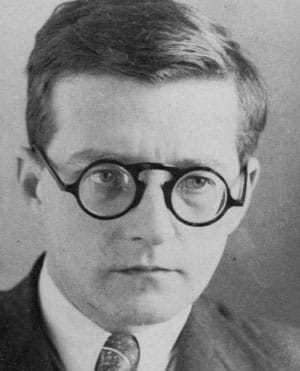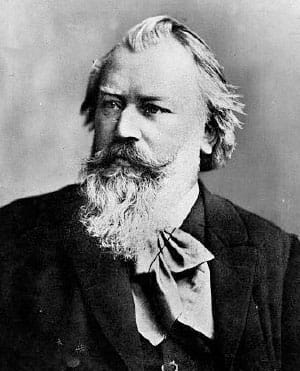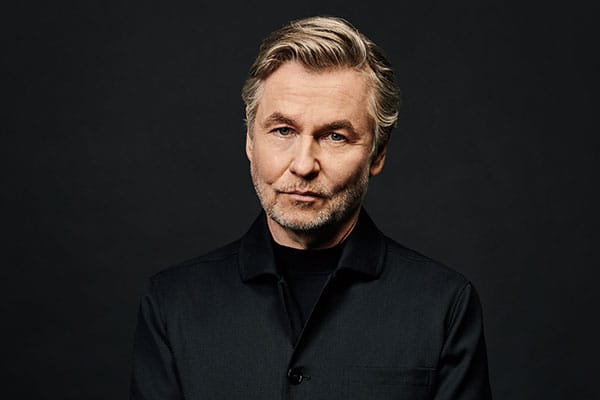In This Program
The Concert
Friday, October 4, 2024, at 7:30pm
Saturday, October 5, 2024, at 7:30pm
Sunday, October 6, 2024, at 2:00pm
Esa-Pekka Salonen conducting
Dmitri Shostakovich
Violin Concerto No. 1 in A minor, Opus 77(99) (1948)
Nocturne
Scherzo
Passacaglia
Burlesca
Sayaka Shoji
Intermission
Johannes Brahms
Symphony No. 4 in E minor, Opus 98 (1885)
Allegro non troppo
Andante moderato
Allegro giocoso
Allegro energico e passionato
Program Notes
At a Glance
At once experimental and deeply traditional, Johannes Brahms’s Symphony No. 4 draws on a lifetime of experience and immersive study. It was his last symphony. The finale, an astonishing interpretation of the time-honored passacaglia form, incorporates part of the bass line of J.S. Bach’s Cantata No. 150, “Nach dir, Herr, verlanget mich” (For Thee, O Lord, I Long).
Violin Concerto No. 1 in A minor, Opus 77(99)
Dmitri Shostakovich
Born: September 25, 1906, in Saint Petersburg
Died: August 9, 1975, in Moscow
Work Composed: 1947–48
SF Symphony Performances: First—December 1960. Enrique Jordá conducted with Leonid Kogan as soloist. Most recent—November 2018. Jakub Hrůša conducted with Karen Gomyo as soloist.
Instrumentation: solo violin, 3 flutes (3rd doubling piccolo), 3 oboes (3rd doubling English horn), 3 clarinets (3rd doubling bass clarinet), 3 bassoons (3rd doubling contrabassoon), 4 horns, tuba, timpani, percussion (tambourine, tam-tam, and xylophone), 2 harps, celesta, and strings
Duration: About 35 minutes

Dmitri Shostakovich spent most of his career falling in and out of favor with the Communist authorities of the Soviet Union. By the mid-1940s his official approval ratings had soared, plummeted, soared again, plummeted again, and soared anew. Then, in 1945, his stock crashed yet another time when his Ninth Symphony struck the bureaucrats as insufficiently reflecting the glory of Russia’s victory over the Nazis. Shortly after that, the USSR entered a period of brutal cultural policy—the Zhdanovshchina, named after the feared Central Committee secretary Andrey Zhdanov. It was he who, in 1934, had overseen the formal declaration of socialist realism as artistic policy. In 1946, with the war out of the way, he jumpstarted his campaign, pushing the argument that “any preaching of ‘art for art’s sake’ . . . is harmful to the interests of the Soviet people and the Soviet state.” He began by addressing the Soviet literary world, with the novelist Boris Pasternak, the poet Anna Akhmatova, and the satirist Mikhail Zoshchenko coming in for especially severe condemnation. From there, he moved on to theater, then to film for particular condemnation.
In February 1948, music got its turn. Zhdanov and his operatives took aim at practically all Soviet composers who would be considered worthy in posterity, accusing them of “formalist perversions and antidemocratic tendencies in music, alien to the Soviet people and its artistic tastes.” Sergei Prokofiev, Nikolai Myaskovsky, and Aram Khachaturian were among the disgraced, and Shostakovich came in for particular disdain due to his opera Lady Macbeth of the Mtsensk District. Shostakovich responded with a pathetic acknowledgement of guilt, and the next year he redeemed himself with The Song of the Forests, a nationalistic oratorio praising Stalin’s efforts at reforestation. It earned him a Stalin Prize backed by 100,000 rubles.
He wrote his Violin Concerto No. 1 in 1947–48, at which time he assigned it the opus number 77. The musicologist Boris Schwarz insisted that Shostakovich indicated that he wanted that opus number to remain attached to the concerto, since it accurately depicted where the piece fell chronologically in his output. But that desire has been generally ignored, with the result that Shostakovich’s Violin Concerto No. 1 is widely identified as his Opus 99, which corresponds to its date of belated publication. What occasioned the delay? The cellist Mstislav Rostropovich blamed the violinist David Oistrakh, who “allowed [it] to lie around waiting for its first performance . . . . To my mind this was shameful and cowardly.” A more thorough account would not neglect to mention that the piece was completed during the prime years of Zhdanovshchina. That Shostakovich himself might well have had qualms about releasing such a composition at that moment must at least be entertained as a possibility. The fact is that Oistrakh provided considerable advice on the crafting of the solo part, did see the piece through its premiere, and, furthermore, was honored by the composer through the score’s dedication.
In March 1948, the violinist Venyamin Basner attended Shostakovich’s last class at the Leningrad Conservatory, during which the composer “played for us for the very first time his newly finished violin concerto. . . . [he] asked if I wouldn’t mind trying something out on the violin,” reported Basner. He continued:
Shaking like a leaf, I got my violin out. The very idea, that I should be the first violinist to attempt to play this difficult music, and, what’s more, to sightread it in the presence of the composer! . . . I was of course present at the first performance of the First Violin Concerto, given by David Oistrakh in Leningrad in 1955. I attended all the rehearsals. The Concerto is a relentlessly hard, intense piece for the soloist. The difficult Scherzo is followed by the Passacaglia, then comes immediately the enormous cadenza which leads without a break into the Finale. The violinist is not given the chance to pause and take breath. I remember that even Oistrakh, a god for all violinists, asked Shostakovich to show mercy. “Dmitri Dmitriyevich, please consider letting the orchestra take over the first eight bars in the Finale so as to give me a break, then at least I can wipe the sweat off my brow.” Immediately Dmitri Dmitriyevich said, “Of course, of course, why didn’t I think of it?” By the next day he had made the necessary correction by giving the first statement of the theme in the Finale to the orchestra. The violin soloist comes in with the passagework afterwards.
The Music
Even with that alteration to the Finale, Shostakovich gives his soloist little rest in this concerto. The piece is cast in four movements (slow-fast-slow-fast, broadly speaking), with the first and third movements dominating in length and mood. The work begins with an extended nocturne, lyrical in its spun-out melody, meditative in its overall stillness. The tempo marking of Moderato does not really indicate a snail’s pace, and the solo line and various orchestral passages advance in flowing triplets; yet the feeling is of stasis. Midway through, the harp (playing harmonics) and the celesta enunciate and develop a cryptic motif; they revisit it when the music dies away at the movement’s very end—the final, icy sonority being enriched by gentle punctuation from tam-tam and timpani.
The second movement reflects the mood of many a Shostakovich scherzo, which is to say that its humor is more sardonic than rib-tickling. The violin slashes at its themes early on, before spilling into a folkish danse macabre. Woodwinds are prominent in the orchestra here, sometimes in unusual combinations, as when flute and bass clarinet serve as the soloist’s only companions for the first 29 measures. In the third movement, a passacaglia with nine variations, it is the horns that first define the atmosphere of solemn grandeur before ceding to the funereal, ever-processing chorale of the other winds. The movement ends in an immense cadenza for the soloist, which builds from mournfulness into abandon, recalling melodies from earlier in the concerto. The cadenza leads without a break to the Finale, which Oistrakh characterized as “a joyous folk party, [with] even the bagpipes of traveling musicians,” to which several passages of whining harmonies seem to allude before the piece reaches its boisterous end.
—James M. Keller
Symphony No. 4 in E minor, Opus 98
Johannes Brahms
Born: May 7, 1833, in Hamburg
Died: April 3, 1897, in Vienna
Work Composed: 1884–85
SF Symphony Performances: First—January 1917. Alfred Hertz conducted. Most recent—February 2020. Herbert Blomstedt conducted.
Instrumentation: 2 flutes (2nd doubling piccolo), 2 oboes, 2 clarinets, 2 bassoons, contrabassoon, 4 horns, 3 trumpets, 3 trombones, timpani, triangle, and strings
Duration: About 40 minutes

Johannes Brahms had sat on his First Symphony for nearly 20 years, making sketches in the late 1850s, but still saying in 1872 that he would “never write a symphony! You can’t have any idea what it’s like always to hear such a giant marching behind you.” It was late 1876 when he at last released the work for performance, but the terror of Beethoven and the terror of the idea of symphony once overcome, his Symphony No. 2 came along quickly—begun, finished, performed, and published, all in 1877. The Third, begun in 1882, was finished in the summer of 1883, and the Fourth was started the following summer. That year Brahms chose Mürzzuschlag in Styria for his annual holiday. “The cherries don’t ever get to be sweet and edible in this part of the world,” he wrote to several of his friends, adding that he feared his new music had taken on something of their flavor.
As always, he announced work in progress with caution. To his publisher he made only some vague noise about a need for paper with more staves. To conductor Hans von Bülow he reported in September 1885: “Unfortunately, nothing came of the piano concerto that I should have liked to write. I don’t know, the two earlier ones are too good or maybe too bad, but at any rate they are obstructive to me. But I do have a couple of entr’actes; put together they make what is commonly called a symphony. On tour with the Meiningen orchestra, I have often imagined with pleasure how it would be to rehearse it with you, nicely and at leisure, and I’m still imagining that now, wondering by the way whether it would have much of an audience.”
Von Bülow, 50 when he began his five-year stint at Meiningen in 1880, was one of the most imposing and brilliant musical personalities of the century. A remarkable pianist, conductor, and polemicist, he was among the most prominent of the Wagnerians and conducted the first performances of Tristan und Isolde and Die Meistersinger von Nürnberg. He was caught in a wretched personal situation when his wife, the daughter of Franz Liszt, left him for Wagner. He continued to conduct Wagner’s music, but he became one of the most fervent admirers and effective champions of Brahms (and thus one of the few to bridge what seemed then a vast gulf between musical ideologies). He was, in any event, delighted to have Brahms come to Meiningen with his new symphony. “Difficult, very difficult,” reported von Bülow after the rehearsals had begun. “No. 4 gigantic, altogether a law unto itself, quite new, steely individuality. Exudes unparalleled energy from first note to last.” The premiere went well, and the audience tried hard but unsuccessfully to get an encore of the scherzo. Von Bülow conducted a repeat performance a week later, after which the orchestra set off on tour, with Brahms conducting the new symphony in Frankfurt, Essen, Elberfeld, Utrecht, Amsterdam, The Hague, Krefeld, Cologne, and Wiesbaden. It was liked and admired everywhere, though Vienna resisted the performance two months later by the Philharmonic under Richter, a performance prepared, unfortunately, nowhere near as well as the series by the Meiningen Orchestra.
While the public took to the Fourth, Brahms’s friends, including professionals and near-professionals like Elisabet von Herzogenberg and critic Eduard Hanslick, had some difficulty with it. Perhaps that can be explained. The public, except in Vienna, heard superbly realized performances, while Hanslick, for example, knew it first from a two-piano reading (he remarked it was like being beaten up by two tremendously intelligent and witty people), and Frau von Herzogenberg had to decipher it at the piano from the manuscript of Brahms’s full score. Then, where the public would have chiefly perceived and been carried by the sweep of the whole, the professionals, with their special kind of connoisseurship and perception of detail, would have been more struck by what was—and is—genuinely difficult in the score.
The Music
It is fascinating to learn that the opening was disconcerting to Brahms’s friend, the violinist Joseph Joachim. Something preparatory, he suggests, even if it were only two measures of unison B, would help listeners find their way into the piece (in fact, reading his correspondence with Brahms, we learn that originally there were some preparatory measures of just that nature which were struck out and destroyed). The second statement of the opening melody was difficult to unravel, the theme itself given in broken octaves and in dialogue between second and first violins, with elaborate decorative material in violas and woodwinds. Almost everyone was upset over what appears now one of the most wonderful strokes in the work, the place where Brahms seems to make the conventional, classical repeat of the exposition but changes one chord after eight measures, thereby opening undreamed-of harmonic horizons; only then, after so leisurely a start, does he move into the closely argued development. On the other hand, everyone admired the dreamily mysterious entry into the recapitulation—the long sequence of sighing one-measure phrases, subsiding, sinking into one of only four places marked ppp in all of Brahms’s orchestral music, from which oboes, clarinets, and bassoons emerge in their severe yet gentle reediness to sound the first four notes of the opening melody, in immense magnification, strings weaving an enigmatic garland about the last note. The next four notes are treated the same way, and then the music’s melancholy flow resumes in the expected way.
For Brahms to build a slow movement over the same keynote as the first movement is rare indeed; yet he does it here and finds an inspired way of celebrating simultaneously the continuity and the contrast of E minor (the first movement) and E major (the second).
After a massively rambunctious scherzo, for the finale, Brahms goes back to the E minor from which he began, but with a theme whose first chord is A minor and thus very close to the world of the just-finished scherzo. Brahms’s knowledge of Baroque and Renaissance music was extensive and profound. When he writes a passacaglia—which must have seemed sheer madness to the up-to-date Wagnerians—he does so like a man composing living music, with no dust of antiquarianism about it. He had been impressed by Bach’s Cantata No. 150, Nach dir, Herr, verlanget mich, whose last movement is a set of variations over a repeated bass, and he maintained that something could still be done with such a bass, though the harmonies would probably have to be made richer. And of course he knew well Bach’s great Chaconne for violin solo.
Woodwinds and brasses, joined at the last by rolling drums, proclaim a sequence of eight chords. The trombones have been saved for this moment, and even now it is characteristic that the statement is forte rather than fortissimo. The movement falls into four large sections. First, 12 statements of the eight-bar set, with bold variations of texture, harmonic detail, and rhetoric; this phase subsides, to inaugurate a contrasting section—first in minor still, but soon to move into major—in which the measures are twice as long, the movement thus twice as slow. Four of these bigger variations make up this section. The original pace is resumed with what appears to be a recapitulation. But strings intervene passionately midway through the eight-chord sequence, and the ensuing 16 variations bring music more urgently dramatic than any yet heard in the symphony. The passion and energy are released in an extensive, still developing, still experiencing coda at a faster speed. Thus the symphony drives to its conclusion, forward-thrusting yet measured, always new in detail yet organically unified, stern, noble, and with that sense of inevitability that marks the greatest music.
—Michael Steinberg
The Brahms Symphony No. 4 note originally appeared in somewhat different form in the program book of the Boston Symphony Orchestra, ©1978, and is reprinted here by permission.
Shostakovich’s Violin Concerto No. 1 and Brahms’s Symphony No. 4 both have movements in passacaglia form (Shostakovich’s third movement and Brahms’s finale). A passacaglia, also known as a chaconne, builds a series of variations over an unchanging and repeated bass line. Originating in the Baroque era with composers like Frescobaldi, J.S. Bach, and Purcell, passacaglias re-emerged in the 19th and 20th centuries as composers looked for new inspiration in older music.
About the Artists

Esa-Pekka Salonen
Music Director
Known as both a composer and conductor, Esa-Pekka Salonen is the Music Director of the San Francisco Symphony. He is the Conductor Laureate of the Los Angeles Philharmonic, where he was Music Director from 1992 until 2009, the Philharmonia Orchestra, where he was Principal Conductor & Artistic Advisor from 2008 until 2021, and the Swedish Radio Symphony Orchestra. As a member of the faculty of Los Angeles’s Colburn School, he directs the preprofessional Negaunee Conducting Program. Salonen cofounded, and until 2018 served as the Artistic Director of, the annual Baltic Sea Festival, which invites celebrated artists to promote unity and ecological awareness among the countries around the Baltic Sea.
Salonen has an extensive and varied recording career. Releases with the San Francisco Symphony include recordings of Kaija Saariaho’s opera Adriana Mater, Bartók’s piano concertos, as well as spatial audio recordings of several Ligeti compositions. Other recent recordings include Strauss’s Four Last Songs, Bartók’s The Miraculous Mandarin and Dance Suite, and a 2018 box set of Mr. Salonen’s complete Sony recordings. His compositions appear on releases from Sony, Deutsche Grammophon, and Decca; his Piano Concerto, Violin Concerto, and Cello Concerto all appear on recordings he conducted himself.
Esa-Pekka Salonen is the recipient of many major awards. Most recently, he was awarded the 2024 Polar Music Prize. In 2020, he was appointed an honorary Knight Commander of the Order of the British Empire (KBE) by the Queen of England.

Sayaka Shoji
Born in Tokyo, Sayaka Shoji moved to Siena, Italy, when she was three. Since winning first prize at the Paganini Competition in 1999, she has appeared with the Israel Philharmonic, Cleveland Orchestra, Los Angeles Philharmonic, New York Philharmonic, London Symphony, Philharmonia Orchestra, Berlin Philharmonic, Orchestra dell’Accademia Nazionale di Santa Cecilia, Czech Philharmonic, Vienna Symphony, Mariinsky Orchestra, and NHK Symphony. Recent highlights include appearances with the Frankfurt Radio Symphony, Hamburg Symphony, BBC Symphony, and a tour with the Modigliani Quartet. She makes her San Francisco Symphony debut with this program, having previously appeared on the Great Performers Series with the Saint Petersburg Philharmonic in 2017.
As a prolific recording artist, Shoji has released 11 albums on Deutsche Grammophon including Prokofiev, Sibelius, and Beethoven violin concertos, and a recital album with Menahem Pressler. In 2022, she released a new album of Mozart sonatas with Gianluca Cascioli, following her previous album of the complete Beethoven sonatas. Alongside her concert and recording activities, Shoji has created an experimental visual music project, Synesthesia, and explored oil painting and video art.
Shoji won the Mainichi Art Award in 2016, one of Japan’s most prestigious awards, presented to those who have had a significant influence on the arts. In 2012, she was named one of the 100 most influential people for the future of Japan by Nikkei Business. She plays the “Recamier” Stradivarius violin, ca. 1729, kindly loaned to her by Ueno Fine Chemicals Industry Ltd.




